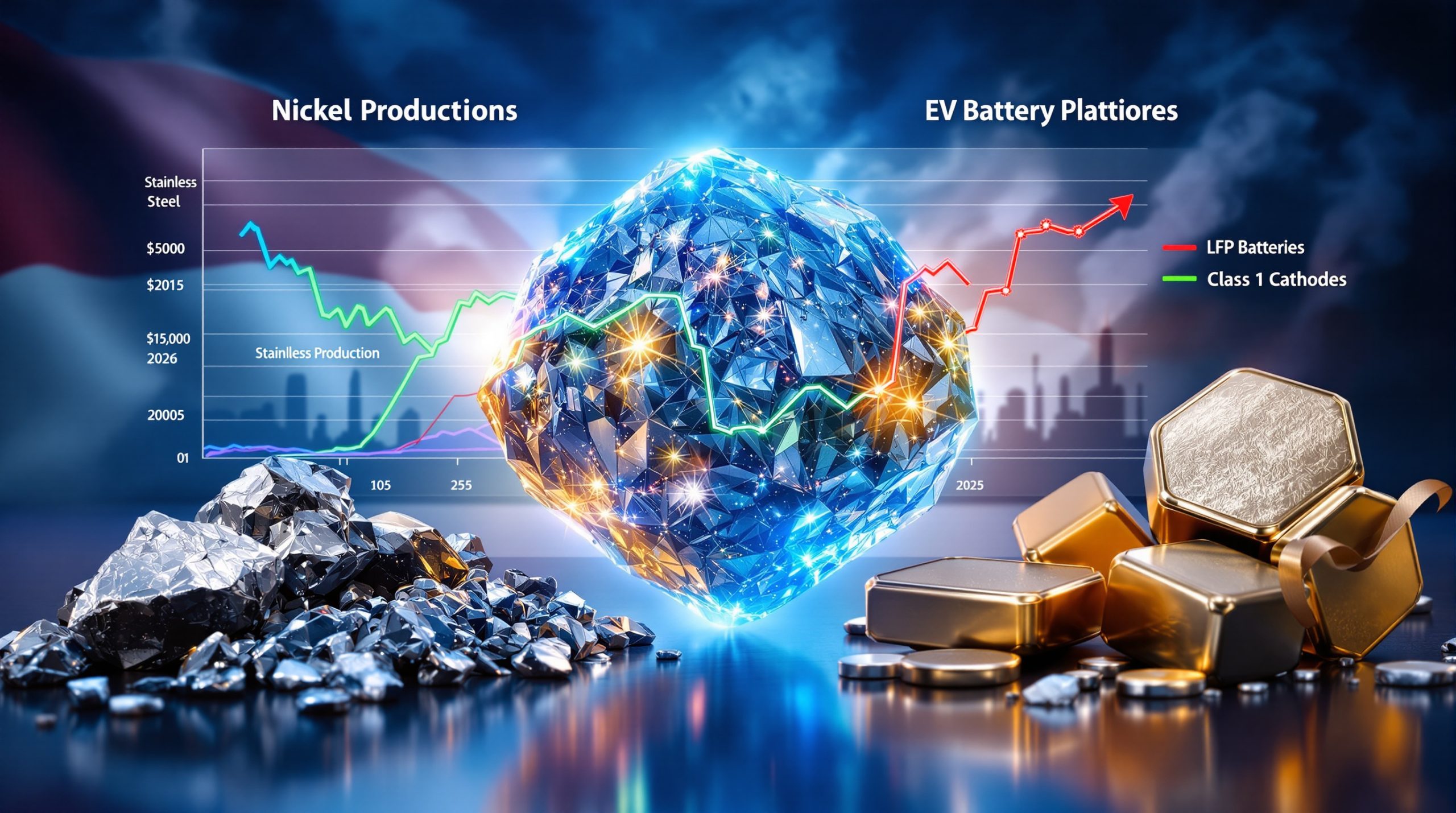What Factors Are Driving Aurubis' Record Copper Premium Increase?
Unprecedented Premium Hike Announcement
Europe's largest copper smelter, Aurubis, has set its 2026 premium at $315 per metric ton, marking a substantial 38% increase from the $228 premium charged in 2025. This unprecedented hike represents the highest premium level ever established by the German copper giant, significantly impacting the market landscape. The premium applies as an additional charge above London Metal Exchange (LME) copper prices, directly affecting costs for European manufacturers and industrial consumers.
The decision comes amid extraordinary market conditions, with LME copper prices recently touching a 16-month high of $10,800 per ton and gaining approximately 8% in value over the past month alone. Market analysts suggest this aggressive pricing strategy reflects Aurubis' anticipation of severe supply constraints persisting through 2026.
Supply Disruption Concerns
Multiple high-impact disruptions at key global mining operations have created a perfect storm for copper supply. Most notably, a catastrophic mudslide at Indonesia's Grasberg mine—the world's second-largest copper producer—has forced Freeport-McMoRan to declare force majeure, slashing production forecasts dramatically. This single event is projected to remove 273,000 tons of copper from global supply between September and December alone.
Compounding these challenges, significant operational difficulties have emerged at the Kamoa-Kakula mine in the Democratic Republic of Congo, where technical issues have reduced output capacity. Simultaneously, Chile's El Teniente operation—one of the world's largest underground copper mines—has faced its own production setbacks, further straining global supply forecast.
These combined disruptions have created substantial uncertainty regarding copper availability for 2026, with limited emergency supply alternatives available to compensate for the shortfall.
Market Fundamentals Shifting
Beyond immediate supply challenges, fundamental market dynamics are tilting in favor of higher premiums. Industrial demand across European manufacturing sectors continues to expand, particularly in electric vehicle production, renewable energy infrastructure, and grid modernization projects—all copper-intensive applications.
Physical copper availability in European warehouses has reached critically low levels, with visible inventories declining consistently throughout 2023-2025. Processing capacity constraints have become increasingly apparent, with European smelters operating near maximum capacity while facing rising operational expenses.
Energy costs remain a persistent challenge for European processors, with natural gas and electricity prices significantly higher than pre-2022 levels despite some moderation. These elevated energy inputs directly impact the cost structure of copper refinement, further justifying premium increases to maintain operational viability.
How Will This Premium Affect The Global Copper Market Balance?
Projected Supply Deficit Scenarios
The copper market appears headed toward its most significant supply shortage in decades. Bank of America has more than doubled its 2026 copper deficit forecast to 350,000 tons, while Societe Generale predicts the largest copper supply deficit since 2004—a dramatic shift from earlier projections of relative market balance.
The loss of 273,000 tons from the Grasberg mine during just a four-month period (September-December) represents only the initial impact of what could be prolonged production challenges. Industry analysis suggests the cumulative effect of multiple simultaneous production disruptions could remove over 500,000 tons of anticipated supply from the 2026 market.
Particularly concerning for market stability is the limited new mining capacity scheduled to come online during this period. Major copper projects typically require 7-10 years from discovery to production, meaning the current supply gap cannot be quickly addressed through new mine development. Existing operations face declining ore grades, requiring more material to be processed for equivalent copper output.
European Manufacturing Cost Implications
European manufacturers will bear the brunt of this premium increase, particularly in copper-intensive industries. Electrical equipment producers—including cable manufacturers, transformer builders, and electrical component makers—face significant input cost increases that will test their pricing power and margin resilience.
The construction sector, already contending with elevated material costs across multiple categories, must now incorporate higher copper expenses into project budding and planning. This could potentially slow development timelines for commercial and residential projects where copper wiring, plumbing, and HVAC components represent substantial cost elements.
For the automotive industry, the premium hike arrives at a particularly challenging moment as manufacturers accelerate electric vehicle production—requiring approximately three times more copper per vehicle than conventional models. This could accelerate research into copper substitution technologies where technically feasible, though copper's unique conductivity properties make full replacement impossible in many applications.
Regional Premium Differentials
With European premiums now substantially higher than other global regions, significant market distortions are emerging. Asian copper premiums currently stand approximately 30% below European levels, creating potential arbitrage opportunities for traders with global logistics capabilities.
North American premium adjustments typically follow European benchmarks with a 3-6 month lag, suggesting similar increases may appear across Atlantic markets by mid-2026. This geographic premium disparity could temporarily advantage Asian manufacturers competing in global markets against European producers, creating cost structure imbalances in finished goods.
The premium differential may also alter global copper shipment patterns, potentially drawing additional material toward higher-premium European destinations while creating localized shortages in other regions. This dynamic highlights copper's increasingly strategic importance in global industrial policy and supply chain security.
What Does The Premium Increase Reveal About Long-Term Copper Market Trends?
Green Energy Transition Demand
The premium surge reflects growing recognition that copper demand fundamentals are undergoing structural transformation driven by the green energy transition. Each megawatt of solar capacity requires approximately 5 tons of copper, while offshore wind installations consume up to 15 tons per megawatt—creating sustained demand growth as renewable deployment accelerates.
Electric vehicle production scaling represents another major demand catalyst, with each battery-electric vehicle requiring 83 kg of copper compared to 23 kg in conventional vehicles. As global EV penetration continues its exponential growth trajectory, surging copper demand from this sector alone could increase by over 1.5 million tons annually by 2030.
Grid modernization projects across Europe and North America are simultaneously consuming significant copper resources, with aging infrastructure replacement and capacity expansion requiring substantial new investment. Energy storage systems—critical for balancing intermittent renewable generation—add further demand pressure, with large-scale battery installations requiring extensive copper in connecting infrastructure.
The combined effect creates a structural demand growth curve for refined copper that appears increasingly difficult to satisfy through conventional supply expansion alone.
Supply-Side Structural Challenges
Beyond immediate disruptions, the premium increase highlights deeper supply-side structural challenges. Average copper ore grades at established mining operations have declined from approximately 1.6% in 1990 to below 0.6% today, requiring significantly more material to be processed for equivalent metal output.
Development timelines for new mining projects have lengthened considerably, with the average copper project now requiring over 16 years from discovery to production—nearly double the historical norm. This extended timeline reflects both increasing geological complexity and heightened regulatory scrutiny.
Permitting hurdles have grown particularly challenging in developed economies, with environmental review processes extending project timelines by 3-5 years on average. Even in traditionally mining-friendly jurisdictions, community opposition and water resource concerns have complicated development pathways.
Production costs have risen across the mining sector, with energy, labor, equipment, and compliance expenses all trending upward. These cost pressures affect mining economics throughout the development cycle, requiring higher long-term price assumptions to justify capital investment.
Market Sentiment Indicators
Forward pricing in copper futures markets suggests sustained tightness, with the forward curve showing backwardation—where futures prices are lower than spot prices—indicating immediate supply scarcity. This market structure typically incentivizes immediate delivery and discourages inventory building.
Investor positioning reflects growing expectations of continued supply constraints, with speculative long positions increasing significantly in recent trading sessions. Major commodity trading houses have similarly adjusted their strategic positioning to prepare for extended market tightness.
Analyst price forecasts have undergone notable upward revisions, with consensus estimates for 2026-2028 copper prices rising by an average of 18% since January. Trading volumes indicate strong market interest in copper futures, with daily turnover reaching multi-year highs on major exchanges.
Perhaps most tellingly, inventory levels across major warehousing systems have reached multi-year lows, with LME stocks covering barely a week of global consumption—an extraordinarily thin buffer against further supply disruptions.
How Are Copper Consumers Responding To Rising Premiums?
Industrial Strategy Adjustments
Major copper consumers are implementing strategic adjustments to navigate the challenging market environment. Long-term contract negotiations have become increasingly supplier-favorable, with fixed-price components giving way to flexible pricing mechanisms and shorter commitment timeframes.
Inventory management strategies are shifting toward security of supply rather than just-in-time efficiency, with many manufacturers increasing their copper stockholdings despite the working capital implications. This strategic stockpiling represents a significant shift from the lean inventory practices that have dominated industrial management for decades.
Product design teams across multiple industries have initiated comprehensive copper utilization reviews, seeking opportunities to optimize material usage without compromising performance. This includes exploring thinner gauge wiring where ampacity requirements allow, increasing the use of copper alloys with lower pure copper content, and redesigning components to minimize copper requirements.
Where market dynamics permit, manufacturers are implementing price pass-through mechanisms to transfer increased copper costs to end customers. However, competitive pressures and long-term customer agreements often limit the effectiveness of such approaches, creating margin pressure when input costs rise rapidly.
Regional Manufacturing Competitiveness
European manufacturers now face higher input costs than global competitors, creating potential competitive disadvantages in international markets. This cost differential is particularly significant for products where copper represents a substantial portion of total material costs, such as electric motors, transformers, and power infrastructure components.
Some production shifting toward regions with lower copper premiums appears inevitable, particularly for copper-intensive products serving global markets. Asia-Pacific manufacturing facilities may gain comparative advantage for export-oriented production until regional premium differences normalize.
Manufacturers with established copper recycling capabilities enjoy significant cost advantages in the current environment, as secondary copper typically trades at a discount to primary metal. This dynamic is accelerating investment in recycling infrastructure and creating value for operations with closed-loop material recovery systems.
Vertical integration strategies have gained renewed attention among larger consumers, with some exploring investment insights in mining assets or processing capacity to secure reliable supply chains. While such backward integration carries significant capital requirements and operational complexity, it provides insurance against future supply disruptions and premium spikes.
Recycling Market Dynamics
Secondary copper sources have become increasingly valuable as premium differentials between primary and recycled material widen. Scrap collection rates are increasing across Europe, supported by both economic incentives and regulatory frameworks promoting circular economy principles.
Investment in copper recycling technologies has accelerated, with advanced sorting systems, improved metallurgical processes, and automated disassembly methods enhancing recovery rates. These technological advances are gradually improving the quality of recycled copper, allowing it to serve applications previously requiring only primary material.
The price spread between primary and secondary copper has narrowed considerably, reflecting the strategic importance of recycled material in balancing market supply. High-grade copper scrap now commands premiums approaching 90% of primary metal value, compared to historical differentials of 70-75%.
Regulatory frameworks increasingly support circular economy initiatives, with extended producer responsibility regulations, landfill restrictions, and recycled content mandates creating structural support for secondary copper markets. These policy mechanisms provide long-term stability for recycling investments beyond immediate market pricing incentives.
What Are The Investment Implications Of Rising Copper Premiums?
Mining Sector Outlook
The economic fundamentals for copper mining projects have improved dramatically, with higher long-term copper price prediction projections enhancing projected returns on capital. Projects previously considered marginally economic now demonstrate robust financial metrics, potentially accelerating development decisions.
Mine development and expansion plans are gaining momentum across the sector, with capital allocation increasingly favoring copper over other base metals. Several major mining companies have announced strategic pivots to increase their copper exposure, recognizing its critical role in the energy transition economy.
Exploration budgets targeting copper resources have expanded significantly, with junior miners and major producers alike increasing their search activities. Particularly attractive are projects in stable jurisdictions with established mining codes and reasonable development timelines.
Merger and acquisition activity appears poised to accelerate, with copper-focused companies commanding valuation premiums relative to diversified miners. Recent transactions have demonstrated willingness to pay strategic premiums for producing assets or advanced-stage development projects with clear paths to production.
Valuation multiples for producers with near-term production growth have expanded, reflecting market recognition of copper's favorable long-term fundamentals. Companies demonstrating ability to bring new capacity online within the next 36 months are particularly well-positioned to benefit from the current market dynamics.
Smelter and Refiner Positioning
Processing margins have expanded significantly for integrated producers controlling both mining and refining capabilities. The combination of higher metal prices and increased treatment charges creates advantageous economics for vertically integrated operations.
Treatment and refining charges (TC/RCs) negotiations have shifted in favor of processing facilities, with miners increasingly willing to accept higher processing costs to ensure production reaches market. This represents a significant shift from the historical balance of power between miners and smelters.
Operational efficiency has become increasingly valuable in the current high-price environment, with each percentage point of recovery improvement translating to substantial financial benefit. Processors have accordingly accelerated investment in efficiency-enhancing technologies and process optimizations.
Energy cost management remains critical to maintaining profitability, as smelting and refining represent energy-intensive processes. European processors face particular challenges in this regard, with energy costs substantially higher than competitors in regions with lower power prices.
The strategic importance of smelting capacity in secure supply chains has gained renewed recognition, with some governments exploring support mechanisms to ensure domestic processing capabilities remain viable despite potential smelter shutdown impact. This policy shift acknowledges copper's critical role in industrial strategy and energy security.
Downstream Industry Challenges
Margin pressure has intensified for copper-intensive manufacturers unable to pass through increased input costs. This pressure appears most acute in competitive consumer product categories where pricing power is limited by substitution options or intense competition.
Inventory valuation effects have become material for many manufacturers, with copper price appreciation creating substantial paper gains on existing stockholdings. While this temporarily enhances reported profitability, it creates potential earnings volatility when prices eventually stabilize or decline.
Working capital requirements have increased significantly for manufacturers maintaining copper inventories, with the combination of higher unit prices and strategic stockpiling consuming financial resources. This dynamic may constrain growth initiatives or require additional capital raising for expansion activities.
Product pricing strategies require adjustment to account for input cost volatility, with some manufacturers implementing copper price adjustment clauses in customer agreements. Such mechanisms transfer some price risk to end customers while protecting manufacturer margins from commodity price swings.
Hedging strategies have gained importance for manufacturers, with forward purchasing, futures contracts, and options strategies increasingly employed to manage price risk. This financial sophistication represents a significant evolution for many small and medium-sized manufacturers previously unaccustomed to active commodity risk management.
Market Outlook: What's Next For European Copper Premiums?
Short-Term Price Dynamics
Further premium increases appear possible if supply disruptions persist beyond current expectations. Particular attention focuses on recovery timelines at Grasberg and other affected operations, with each month of extended disruption removing substantial material from global supply.
Seasonal demand patterns will influence physical market tightness, with construction and manufacturing activity typically peaking in the second and third quarters. This seasonality could exacerbate spot market premiums during high-demand periods of 2026.
Inventory drawdowns continue accelerating across European warehouses, with visible stocks declining to critical levels. This inventory depletion removes the traditional buffer against supply chain disruptions, potentially amplifying price volatility during supply interruptions.
Spot market transactions increasingly show significant premiums over benchmark prices, indicating immediate physical availability carries substantial value. This spot premium differential suggests official premium levels may lag actual transaction prices in tight market conditions.
Import/export flows are adjusting to regional premium differentials, with material increasingly drawn toward higher-premium European destinations. This arbitrage-driven reallocation helps balance regional markets but operates with significant time lags due to shipping constraints and contract commitments.
Medium-Term Market Balance Projections
Supply response from the mining sector faces extended timelines, with new capacity typically requiring 3-5 years from investment decision to production. This structural lag between price signals and production response creates extended periods where market imbalances persist despite economic incentives for expansion.
Demand growth trajectory remains robust through the energy transition, with copper requirements for renewable energy, electrification, and grid modernization creating sustained consumption increases. Annual demand growth of 2.5-3% appears sustainable through 2030, requiring approximately 600,000 tons of additional supply annually.
Recycling capacity expansion will partially offset primary supply constraints, with secondary copper accounting for an increasing proportion of total market supply. However, recycling growth faces inherent limitations based on historical consumption patterns and material availability for recovery.
Regional processing capacity investments will affect premium structures over time, with new or expanded smelting facilities potentially alleviating localized supply constraints. Several projects are under consideration globally, though permitting challenges and capital requirements create significant development hurdles.
Technological innovations could potentially affect copper intensity of use, with material science advancements offering limited substitution potential in some applications. However, copper's fundamental properties—particularly its electrical conductivity and durability—remain unmatched for critical applications, constraining substitution possibilities.
Strategic Considerations For Market Participants
Long-term contract structures are evolving to address market volatility, with traditional annual benchmarks giving way to more flexible arrangements incorporating index-based pricing and shorter commitment periods. These structural changes reflect uncertainty regarding future market conditions and reluctance to lock in fixed terms.
Risk management approaches require reassessment across the copper value chain, with traditional strategies insufficient for current volatility levels. Sophisticated scenario planning, diversified supply strategies, and financial hedging increasingly characterize leading organizations' approaches.
Supply chain resilience has become a strategic priority, with redundancy and diversification replacing efficiency as primary design considerations. This shift represents recognition that supply continuity carries significant value in critical material categories like copper.
Geographic diversification of supply sources continues gaining importance, with overreliance on any single producing region now viewed as a strategic vulnerability. This diversification imperative drives exploration investment in historically overlooked jurisdictions that offer reasonable stability and workable mining codes.
Vertical integration opportunities are receiving increased attention from both upstream and downstream market participants, with secure supply chains valued more highly than theoretical market efficiency. These integration initiatives range from formal joint ventures to strategic equity investments and long-term supply contracts.
FAQ: European Copper Premium Increases
What exactly is the European copper premium?
The European copper premium represents an additional charge above the London Metal Exchange (LME) price that customers pay to secure physical delivery of refined copper in Europe. It reflects regional supply-demand dynamics, processing costs, and delivery terms specific to the European market. The premium compensates producers for converting commodity-grade copper into specific shapes (cathodes, rods, etc.) meeting industrial specifications and delivering to European destinations.
Why has Aurubis increased its premium so significantly?
Aurubis has raised its premium substantially due to anticipated copper supply shortages, production disruptions at major mines globally, strong industrial demand, and tightening physical market conditions in Europe. The 38% increase reflects severe market tightness expected in 2026. Additionally, rising energy costs, transportation expenses, and operational expenses have contributed to the producer's need to implement higher premiums to maintain sustainable operations.
How does this premium increase affect end consumers?
End consumers will likely experience higher prices for copper-containing products as manufacturers pass through increased input costs. Industries particularly affected include electrical equipment, construction, automotive, and consumer electronics, where copper is an essential component. The premium increase typically propagates through the supply chain, ultimately affecting retail prices for copper-intensive consumer goods from appliances to electronics.
Are other regions experiencing similar premium increases?
While the European premium has seen the most dramatic increase, other regions are also experiencing upward pressure on physical delivery premiums. Regional differences in supply-demand balance, import/export dynamics, and local processing capacity affect premium levels across global markets. Asian premiums have begun trending upward, though they remain below European levels, while North American premiums typically adjust with some lag to European benchmark movements.
Comparative Analysis: Historical European Copper Premiums
| Year | Aurubis European Premium ($/ton) | Year-over-Year Change | Market Context |
|---|---|---|---|
| 2026 | $315 | +38% | Supply deficit, production disruptions |
| 2025 | $228 | 0% | Balanced market conditions |
| 2024 | $228 | 0% | Stable supply-demand fundamentals |
| 2023 | $228 | +15% | Post-pandemic industrial recovery |
| 2022 | $198 | +67% | Supply chain disruptions, energy crisis |
| 2021 | $118 | +26% | Economic reopening, stimulus effects |
| 2020 | $94 | -8% | Pandemic-related demand reduction |
Disclaimer: The copper market is subject to significant volatility and uncertainty. Forecasts and projections represent current market expectations but may change substantially based on future supply disruptions, policy changes, or economic conditions. Investors and industry participants should conduct independent research before making financial or operational decisions based on market premium information.
Are You Looking to Capitalise on the Next Major Mineral Discovery?
Discover why copper supply disruptions like the Grasberg mine catastrophe create unique investment opportunities before the broader market reacts. Experience real-time alerts on significant ASX mineral discoveries through Discovery Alert's proprietary Discovery IQ model by visiting https://discoveryalert.com.au/discoveries/ and begin your 30-day free trial to gain this crucial market advantage.




